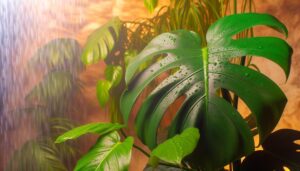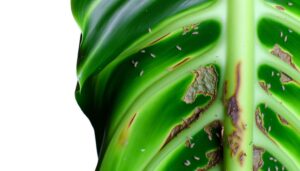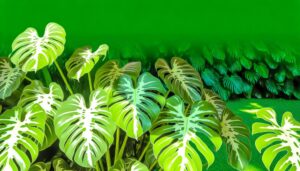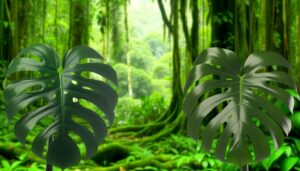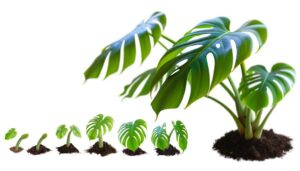Monstera Borsigiana Light Requirements
Your Monstera Borsigiana thrives in bright, indirect light, mimicking its tropical rainforest origins. Aim for a PAR range of 100-200 µmol/m²/s and place it near an east or north-facing window.
Avoid direct sunlight to prevent photodamage and leaf scorch. Seasonal light adjustments matter—closer to windows in winter, further away in summer.
For ideal growth, maintain light at 10,000 to 20,000 lux. Consider full-spectrum LED grow lights for supplemental lighting, especially in low light conditions, to support chlorophyll synthesis and prevent etiolation.
Understanding these factors helps you optimize its photosynthetic efficiency and energy production. Continue for tailored insights.
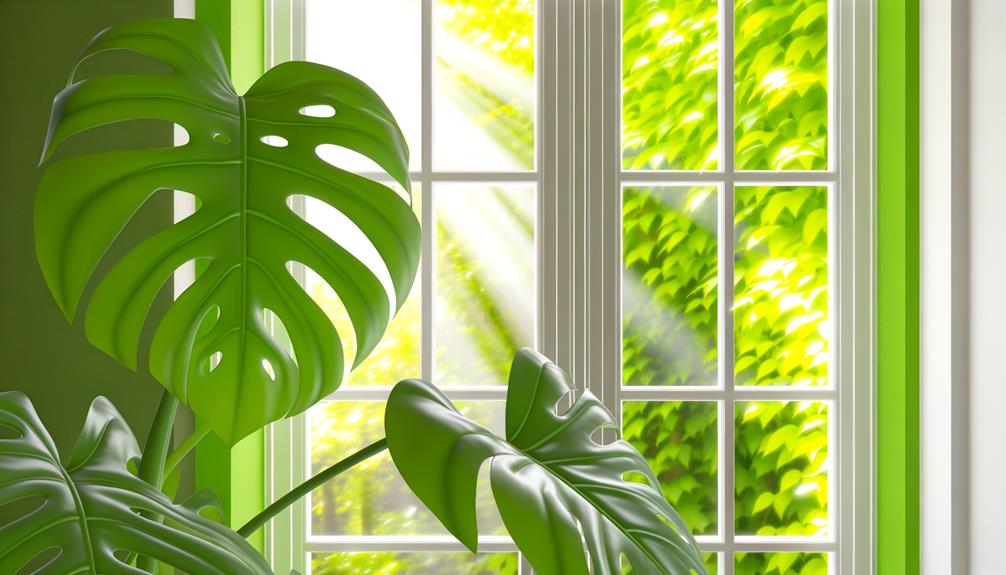
Key Takeaways
- Flourishes in bright, indirect light to avoid leaf scorch.
- Ideal PAR range for growth is 100-200 µmol/m²/s.
- Place near east or north-facing windows for optimal light.
- Adjust light positioning seasonally; closer to windows in winter, away in summer.
- Use full-spectrum LED grow lights to supplement natural light.
Natural Habitat
In its natural habitat, Monstera borsigiana flourishes under the canopy of tropical rainforests, where it receives filtered sunlight through the dense foliage. You'll find this plant in regions characterized by high humidity and consistent temperatures, typically between 20°C and 30°C.
The dense canopy above guarantees that the Monstera borsigiana isn't exposed to direct sunlight, safeguarding its broad, fenestrated leaves from potential photodamage.
The microclimate in these rainforests provides ideal conditions for the plant's epiphytic growth. It attaches itself to tree trunks, using aerial roots to anchor and absorb moisture and nutrients from organic debris.
Understanding these environmental parameters is essential for replicating similar conditions in artificial settings, optimizing the Monstera borsigiana's healthy growth and development.
Light Intensity
Adequate light intensity for Monstera borsigiana involves providing bright, indirect light, mimicking the dappled sunlight it receives in its native rainforest habitat. This species thrives under a photosynthetically active radiation (PAR) range of 100-200 µmol/m²/s, which enhances chlorophyll production and ideal growth.
Avoid direct sunlight, as it can cause photoinhibition, leading to chlorophyll degradation and leaf scorching. Conversely, insufficient light results in etiolation, characterized by elongated stems and smaller leaves. Utilize light meters to measure PAR levels accurately.
Artificial grow lights, emitting a full spectrum, can supplement natural light, ensuring consistent light intensity. Maintain an even photoperiod, approximately 12-14 hours daily, to simulate natural conditions and promote robust photosynthesis.
Ideal Window Placement
For best growth, place your Monstera borsigiana near an east or north-facing window to make sure it receives bright, indirect light without the risk of direct sun exposure. This positioning optimizes photosynthesis while minimizing photoinhibition, which can cause leaf scorching.
Consider these points to create the ideal environment:
- Diffuse Light: East and north-facing windows provide gentle, diffused light ideal for chlorophyll synthesis.
- Temperature Regulation: These orientations help maintain stable temperatures, avoiding thermal stress.
- Humidity Maintenance: Proximity to these windows supports ambient humidity levels, essential for stomatal function and gas exchange.
- Avoidance of Photodamage: Limits the risk of photodamage caused by intense, direct sunlight, ensuring healthy leaf morphology.
Direct Vs. Indirect Light
Understanding the distinction between direct and indirect light is crucial for optimizing the health and growth of your Monstera borsigiana. Direct light involves unobstructed sunlight hitting the plant, which can cause photodamage and leaf scorch due to high irradiance.
Conversely, indirect light is diffused, typically filtered through curtains or reflected off surfaces, offering ample photosynthetically active radiation (PAR) without the intensity that harms foliage. You should aim for bright, indirect light to replicate the dappled sunlight of Monstera's native tropical understory environment. Position your plant near east or north-facing windows where it receives adequate but non-harsh light.
Avoid excessive direct exposure, which can disrupt chlorophyll function and impede growth. Proper light balance guarantees robust, healthy development.
Seasonal Light Changes
In addition to understanding the nuances of direct and indirect light, it's also crucial to take into account how seasonal light changes affect your Monstera borsigiana's light requirements. During winter months, the sun's lower angle and shorter days reduce light intensity. Conversely, summer offers prolonged exposure to intense light. You'll need to adjust its positioning to ensure best photosynthetic activity.
Consider the following:
- Winter: Relocate closer to windows for maximum light absorption.
- Summer: Move away from direct sunlight to prevent photoinhibition.
- Spring/Autumn: Moderate light suffices, as the sun's angle and duration are balanced.
- Artificial Lighting: Supplementary light can stabilize conditions during low-light seasons.
Adjusting for these fluctuations guarantees your Monstera thrives year-round.
Signs of Too Much Light
When your Monstera Borsigiana receives excessive light, you'll observe distinct physiological stress responses. Leaf burn manifests as brown, crispy edges, while chlorosis leads to a noticeable fading of leaf color.
Additionally, photoinhibition can result in stunted growth patterns, indicating impaired photosynthetic efficiency.
Leaf Burn Symptoms
Excessive light exposure can cause Monstera Borsigiana leaves to exhibit symptoms such as browning edges and scorched patches, indicating leaf burn. You'll notice these signs when the plant's photosynthetic cells are damaged due to intense light.
Key indicators include:
- Necrotic Leaf Margins: The edges of the leaves turn brown and crispy due to cell death.
- Scorched Patches: Irregular, discolored areas appear, resembling sunburn.
- Yellowing Leaves: Chlorosis, where leaves lose their green pigment, often accompanies leaf burn.
- Leaf Curling: Leaves may curl inward as a stress response to excessive light.
These symptoms are a clear indication that your Monstera Borsigiana is receiving too much light, necessitating immediate adjustments to its light exposure.
Faded Leaf Color
Another clear indicator that your Monstera Borsigiana is being negatively affected by too much exposure to light is the fading of its leaf color, where vibrant green hues become lackluster and washed out.
This discoloration happens because of the deterioration of chlorophyll, the pigment responsible for photosynthesis. Excessive light intensity speeds up chlorophyll breakdown, resulting in a decrease in the plant's capacity to effectively capture light energy.
You'll observe a transition from deep green to pale, almost see-through shades. This photoinhibition not only compromises visual attractiveness but also hinders the plant's metabolic processes.
Stunted Growth Patterns
Stunted growth in Monstera Borsigiana, often characterized by shorter internodes and smaller leaves, signifies that the plant is receiving excessive light, which disrupts its normal growth patterns and metabolic functions. When exposed to too much light, the plant's photosynthetic machinery becomes overactive, leading to stress and diminished growth.
You might observe the following signs:
- Reduced leaf size: Leaves appear smaller and less vibrant.
- Shortened internodes: The distance between leaf nodes decreases, giving the plant a compact appearance.
- Leaf curling: Leaves may curl inward or develop a scorched appearance.
- Discoloration: A yellow or bleached hue can suggest photoinhibition.
Understanding these symptoms helps you adjust light exposure, ensuring ideal conditions for your Monstera Borsigiana's health.
Signs of Insufficient Light
A common sign of insufficient light in Monstera Borsigiana is the elongation of its stems, known as etiolation, as the plant stretches towards the nearest light source. This phenomenon results from the plant's need to maximize photon capture for photosynthesis.
You'll also notice smaller, paler leaves that lack the characteristic fenestrations. Chlorosis, or yellowing of the leaves, may occur due to impaired chlorophyll production. Reduced internodal spacing, where leaves are spaced further apart, is another indicator.
Additionally, the overall growth rate slows significantly, demonstrating an inability to carry out adequate energy synthesis. Monitoring these symptoms closely allows you to adjust light conditions promptly, ensuring the Monstera Borsigiana thrives and maintains its distinctive appearance.
Supplemental Lighting Options
To optimize the growth conditions for Monstera Borsigiana, incorporating artificial light sources like LED grow lights can effectively supplement natural sunlight. LED grow lights emit specific wavelengths ideal for photosynthesis, ensuring your plant gets the appropriate light spectrum.
When choosing supplemental lighting, consider these options:
- Full-spectrum LED grow lights: Mimic natural sunlight and promote balanced growth.
- Blue light LEDs: Enhance chlorophyll production, fostering healthy leaf development.
- Red light LEDs: Stimulate flowering and fruiting, although less critical for Monstera.
- Adjustable light intensity: Allows customization based on plant needs and growth stages.
Light and Growth Rate
Perfect light conditions directly influence the growth rate of Monstera Borsigiana by enhancing photosynthetic efficiency and energy production.
When you provide bright, indirect light, it enhances chlorophyll activation, accelerating carbon fixation during the Calvin cycle. This, in turn, boosts the synthesis of glucose, essential for cellular respiration and growth.
Insufficient light, however, reduces photosynthetic rates, leading to etiolation—causing elongated stems and sparse foliage. You'll notice slower growth and weaker structural integrity as a result.
Conversely, excessive light can cause photoinhibition, damaging chloroplasts and reducing overall photosynthetic capacity. Maintaining a balanced light environment is essential.
Aim for 10,000 to 20,000 lux for best growth, ensuring your Monstera Borsigiana thrives with robust foliage and vigorous development.
Conclusion
Imagine your Monstera borsigiana thriving, its leaves lush and vibrant. But wait—are you truly giving it the light it needs?
This delicate balance of light intensity, ideal window placement, and understanding direct versus indirect light is essential. Miss any detail, and there are telltale signs—wilting leaves, stunted growth.
Yet, with careful observation and perhaps supplemental lighting, you can reveal its full potential. Will you master this intricate dance of light and growth?
Your plant's fate hangs in the balance.

